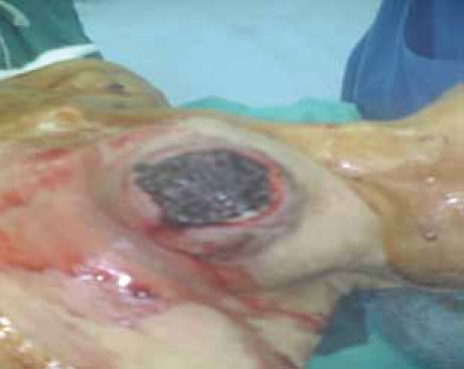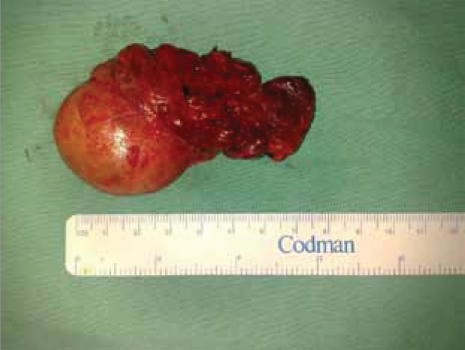Abstract
Goitre is a slow-growing thyroid mass, rarely presenting as an emergency. However, a superimposed infection or acute intralesional bleeding can cause the mass to increase rapidly in size. We report a patient with long-standing multinodular goitre who presented with bleeding from the left thyroid mass. Despite all appropriate measures, the continuous bleeding finally stopped upon thyroidectomy.
Keywords: Goitre, bleeding, thyroidectomy, medical sciences
Case Report
A 70-year-old Malay female presented with a long-standing thyroid mass of more than ten years. There was a history of left lobectomy for a similar problem in the past. However, the mass reappeared several years after the operation; the patient could not recall the exact duration of the symptom-free period. For the previous two years, she had noted that the swelling was growing rapidly. It was associated with bluish discoloration of the skin at the most prominent site of the swelling. Initially, she was examined in the clinic a few weeks before her presentation. Ultrasonography of the mass revealed that it was a thyroid mass with both solid and cystic components. There was increased vascularity at the periphery of the mass near the skin. A few paratracheal lymph nodes were also present. Fine needle aspiration showed signs of colloid goitre. She was scheduled for a complete thyroidectomy at a given date.
She presented earlier than the given date because of bleeding from the mass. There was slow but continuous oozing from the surface of the lesion (Figure 1). Neither the mass nor the bleeding was pulsatile. The bleeding surface area measured 4 × 4 cm. However, the mass had not increased in size. Her haemoglobin level on admission was 7 g/dL. She was managed conservatively with packed cell transfusion, intravenous fluid volume replacement and compression dressing. However, the dressing was soaked with blood every 3 to 4 hours.
Figure 1:
Bleeding from the mass
An emergency thyroidectomy was planned in order to arrest the bleeding. She underwent a complete thyroidectomy on the next day (Figure 2). Recurrent laryngeal nerves were preserved. As the left lobe extended infraclavicularly, a careful dissection was made in order to avoid thoracic duct injury. The wound was closed in the usual manner after securing all the bleeding. Histological reports revealed that it was nodular goitre with intralesional haemorrhage. Lymph nodes removed showed reactive changes.
Figure 2:
Removed specimen
Discussion
Thyroid swelling rarely presents as an emergency situation. Surgery, if indicated, is usually carried out in an elective manner after a thorough investigation, which includes a thyroid function test, fine needle aspiration, ultrasonography and, sometimes computed tomography and thyroid scans are done. The type of surgery required is determined by the clinical, radiological and histological results of the needle aspiration study.
Most of the emergency cases involving goitre include compromised airways. Tracheal compression due to the growing goitre usually requires intubation with a smaller size endotracheal tube. Emergency thyroidectomy under regional anaesthesia (bilateral superficial cervical plexus block) has been reported for severe airway obstruction (1).
Bleeding from a benign thyroid swelling is usually managed by conservative measures such as compressive dressing and replacement of the blood loss. Usually, surgery will be undertaken when the bleeding stops. However, intrathyroidal bleeding can present as an acute problem. Extensive intralesional bleeding can result in a rapidly expanding haematoma with airway compromise (2). If the collection slowly progresses and remains confined intralesionally, the patient may develop chronic symptoms, such as dysphagia, neck pain, chronic cough and throat discomfort. Calcification of such haemorrhages may also occur (3). Potential causes of thyroid bleeding include malignant changes, systemic haematological disorders and hypervascular lesion of the thyroid. Bleeding from previous needle aspiration could be considered if a large-bore needle was used and the procedure was recently done.
Our case illustrates an intralesional thyroid haemorrhage that emerged via the thinning of the skin. As the bleeding was from the thyroid itself, performing thyroidectomy as an emergency surgery effectively arrested the haemorrhage. Superselective embolization, although it is available in our centre, may not have been beneficial to this patient, as the bleeding was very superficial, both by clinical and radiological assessments. Total thyroidectomy and central neck dissection were opted for, in consideration of the age of the patient, the long-standing nature of the swelling and the presence of multiple, small cervical lymph nodes in the paratracheal region.
Footnotes
Author’s contributions
Conception and design, drafting of article: IM
Critical revision and final approval of the article: IM, SJWD
References
- 1.Kolawole IK, Rahman GA. Emergency thyroidectomy in a patient with severe upper airway obstruction caused by goiter: case for regional anesthesia. J Natl Med Assoc. 2006;98:86–89. [PMC free article] [PubMed] [Google Scholar]
- 2.Tsilchorozidou T, Vagropoulus I, Karagianidou C, Grigoriadis N. Huge intrathyroidal hematoma causing airway obstruction: a multidisciplinary challenge. Thyroid. 2006;16:795–799. doi: 10.1089/thy.2006.16.795. [DOI] [PubMed] [Google Scholar]
- 3.Yuzbasioglu MF, Ozkaya M, Ezberci F, Senoglu N, Kizildag B. Eggshell calcification after intrathyroidal hemorrhage of retrosternal thyroid. Cases J. 2008;1:11. doi: 10.1186/1757-1626-1-11. [DOI] [PMC free article] [PubMed] [Google Scholar]




